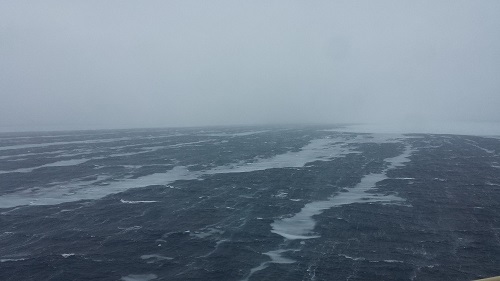Update
We navigated through the sea ice and made it into a polynya near the coast by Dibble Glacier. We’re doing a CTD about every other day looking for the warm water intrusion and we’re constantly mapping the ocean bottom looking for troughs and collecting new data. We’ve mapped areas of the continental shelf never seen before!
Being in the polynya there is a lot of wind and we get to see a variety of stages of new sea ice formation, but it’s also really cold. Going outside today, with the wind chill it was about -50F. Even inside the lab, while we process data, it’s about 56F. We’re definitely in Antarctica!
 Dominique Richardson waves "hi" from behind the bridge in -50F. Photo by Alex Fraser.
Dominique Richardson waves "hi" from behind the bridge in -50F. Photo by Alex Fraser.
Polynyas
Polynyas are areas of open water within sea ice, found in the polar regions. These are the areas where we will be spending a lot of our time to collect data on ice stream dynamics and map the continental shelf of Antarctica.
 Katabatic winds blow away sea ice creating a polynya. Note the wind lines in the ice and water.
Katabatic winds blow away sea ice creating a polynya. Note the wind lines in the ice and water.
There are two different types of polynyas: sensible heat polynyas and latent heat polynyas. In sensible heat polynyas, warm water comes up from below and keeps ice from forming at the ocean’s surface, resulting in small open water areas in the surrounding ice. In latent heat polynyas, katabatic winds (very strong winds coming off the continent) push ice away from the coast resulting in small open water areas.
Latent heat polynyas are more than just areas of small open water that make our research easier. This particular type of polynya plays an important role in the circulation patterns of the entire ocean. The high sea ice production in these types of polynyas lead to production of large amounts of very dense (very salty and cold) water, which sinks and becomes a major factor in driving global thermohaline circulation.
On the surface of the ocean, currents and water movement are usually wind driven. However, the wind doesn’t directly affect deep ocean circulation. The deep ocean still moves, it is just driven by differences in the temperature (thermo) and salinity (haline) of water masses. This thermohaline circulation, or movement of water based on their density (a combination of temperature and salinity), is like a great conveyer belt in the deep ocean, transporting water—and nutrients and heat—across the planet.
It may seem strange that small patches of ice free water can drive ocean circulation, but the dynamics of the latent heat polynyas produce a lot of very, very dense water. As sea ice forms, ice crystals push out excess salt, making the water surrounding the ice more salty. After the sea ice forms, the strong katabatic winds push that ice away, leaving open areas for more ice to form, excluding more salt, and the process repeats. This leads to a lot of really cold, salty and therefore very dense water, that sinks deep into the ocean. As these dense water masses move, they push and pull on other water masses, contributing to the circulation of the deep ocean.
Try it on your own
See thermo (or haline) circulation in action!
When very dense water is above lighter water it sinks and drives circulation like in the latent heat polynyas. But when light water is above heavy water it can actually prevent water from mixing. When the density difference in the water that prevents mixing is due to temperature the point where the water doesn’t mix is called a thermocline. When the density different is due to salinity, the area of non-mixing is called a halocline. You can create water circulation or thermoclines at home.
You’ll need: 2 small, empty identical bottles with flat lips (like mini plastic water bottles); ice cold water; warm water; blue food dye; red food dye; playing card or cardstock paper; and a tray; (optional salt).
Be sure to do this over a tray or bin in case you spill. * Fill one of the water bottles with ice cold water (no ice chunks) and add just a little blue food dye. Be sure the bottle is filled all the way to the lip of the bottle. * Fill the other bottle with warm water from the sink and add just a little red food day. Be sure the bottle is filled all the way to the lip of the bottle. * Place the playing card over the warm, red bottle, then carefully, over the tray, flip the warm bottle over onto the top of the cold, blue water bottle (card in between). * Align the bottles perfectly. When the bottles are balanced and perfectly matched up, carefully remove the playing card out from between the two bottles. You may need to hold the top bottle in place. What do you see? Try flipping the bottles around. Now what happens?
You can also try this with salt (haline circulation), by making one of the water bottles very salty and leaving the other one as fresh water. You can even try mixing temperature and salinity to create different densities and test out thermohaline circulation.

